2005 Hyundai H-1 (Grand Starex) air conditioning
[x] Cancel search: air conditioningPage 94 of 205

3 STARTING AND OPERATING
26
o Keep your car in good condition. Forbetter fuel economy and reduced maintenance costs, maintain your car in accordance with the mainte- nance schedule in Section 6. If youdrive your car in severe conditions, more frequent maintenance is re- quired (see Section 6 for details).
o Keep your car clean. For maximum service, your Hyundai should bekept clean and free of corrosivematerials. It is especially important that mud, dirt, ice, etc. not be al- lowed to accumulate on the under-side of the car. This extra weight can result in increased fuel con- sumption and also contribute to cor-rosion.
o Travel lightly. Don't carry unneces-
sary weight in your car. Weight re-duces fuel economy.
o Don't let the engine idle longer than
necessary. If you are waiting (andnot in traffic), turn off your engine and restart only when you're ready to go. o Remember, your Hyundai does not
require extended warm-up. As soonas the engine is running smoothly, you can drive away. In very cold weather, however, give your enginea slightly longer warm-up period.
o Don't "lug" or "over-rev" the engine.
Lugging is driving too slowly in toohigh a gear resulting in the engine bucking. If this happens, shift to a lower gear. Over-revving is racingthe engine beyond its safe limit. This can be avoided by shifting at the recommended speeds.
o Use your air conditioning sparingly. The air conditioning system is oper-ated by engine power so your fueleconomy is reduced when you use it.
o Don't "ride" the brake or clutch pedal.
This can increase fuel consumption and also increase wear on these components. In addition, driving with your foot resting on the brake pedalmay cause the brakes to overheat, which reduces their effectiveness and may lead to more serious con-sequences.
o Take care of your tires. Keep them
inflated to the recommended pres-sure. Incorrect inflation, either too much or too little, results in unnec- essary tire wear. Check the tire pres-sures at least once a month.
o Be sure that the wheels are aligned
correctly. Improper alignment canresult from hitting curbs or driving too fast over irregular surfaces. Poor alignment causes faster tire wearand may also result in other prob- lems as well as greater fuel con- sumption.
Page 126 of 205
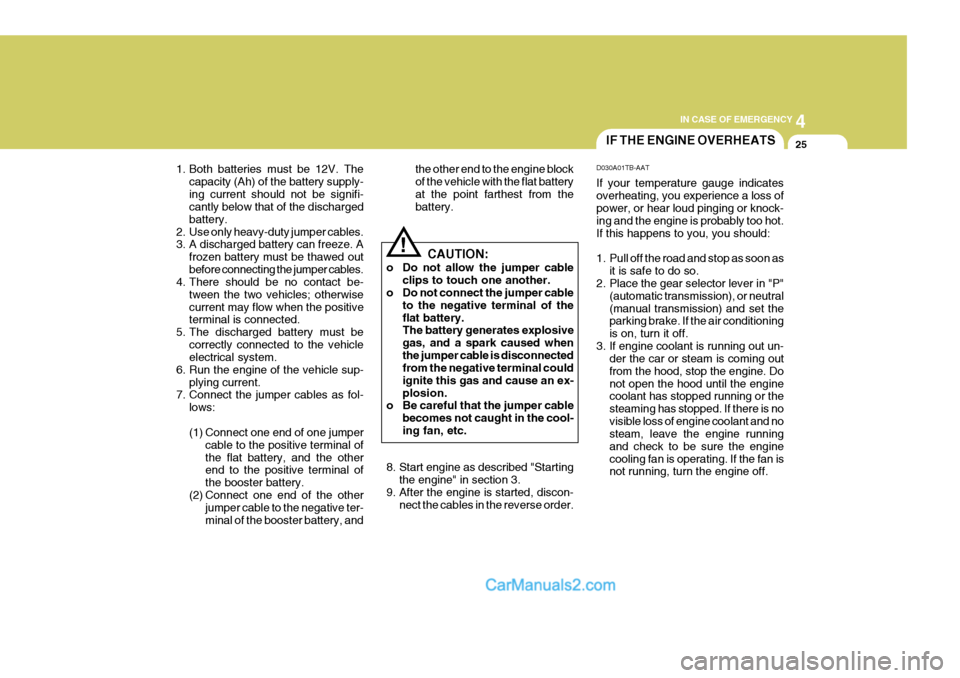
4
CORROSION PREVENTION AND APPEARANCE CARE
25
4
IN CASE OF EMERGENCY
25IF THE ENGINE OVERHEATS
CAUTION:
o Do not allow the jumper cable clips to touch one another.
o Do not connect the jumper cable
to the negative terminal of the flat battery. The battery generates explosive gas, and a spark caused whenthe jumper cable is disconnected from the negative terminal could ignite this gas and cause an ex-plosion.
o Be careful that the jumper cable
becomes not caught in the cool-ing fan, etc.
! D030A01TB-AAT If your temperature gauge indicates overheating, you experience a loss of power, or hear loud pinging or knock- ing and the engine is probably too hot.If this happens to you, you should:
1. Pull off the road and stop as soon as
it is safe to do so.
2. Place the gear selector lever in "P"
(automatic transmission), or neutral (manual transmission) and set the parking brake. If the air conditioning is on, turn it off.
3. If engine coolant is running out un- der the car or steam is coming outfrom the hood, stop the engine. Donot open the hood until the engine coolant has stopped running or the steaming has stopped. If there is novisible loss of engine coolant and no steam, leave the engine running and check to be sure the enginecooling fan is operating. If the fan is not running, turn the engine off.
the other end to the engine block of the vehicle with the flat batteryat the point farthest from the battery.
8. Start engine as described "Starting the engine" in section 3.
9. After the engine is started, discon- nect the cables in the reverse order.
1. Both batteries must be 12V. The
capacity (Ah) of the battery supply- ing current should not be signifi- cantly below that of the discharged battery.
2. Use only heavy-duty jumper cables.
3. A discharged battery can freeze. A
frozen battery must be thawed out before connecting the jumper cables.
4. There should be no contact be-
tween the two vehicles; otherwisecurrent may flow when the positive terminal is connected.
5. The discharged battery must be correctly connected to the vehicleelectrical system.
6. Run the engine of the vehicle sup- plying current.
7. Connect the jumper cables as fol-
lows:
(1) Connect one end of one jumper cable to the positive terminal of the flat battery, and the other end to the positive terminal of the booster battery.
(2) Connect one end of the other jumper cable to the negative ter-minal of the booster battery, and
Page 127 of 205
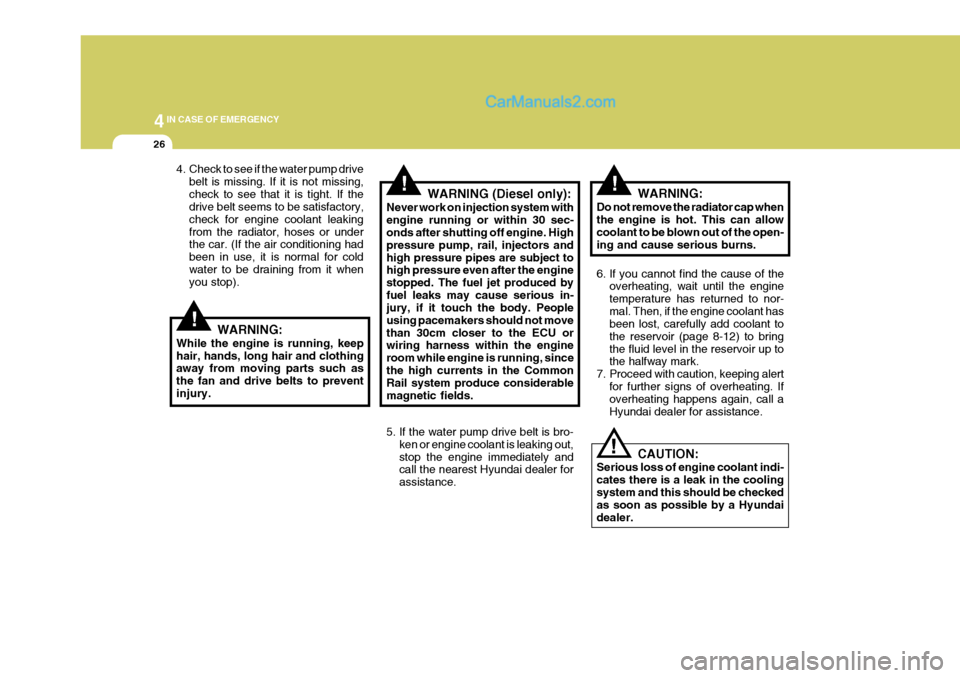
44IN CASE OF EMERGENCY
26
4. Check to see if the water pump drivebelt is missing. If it is not missing, check to see that it is tight. If the drive belt seems to be satisfactory, check for engine coolant leakingfrom the radiator, hoses or under the car. (If the air conditioning had been in use, it is normal for coldwater to be draining from it when you stop).
!WARNING:
While the engine is running, keep hair, hands, long hair and clothing away from moving parts such as the fan and drive belts to preventinjury.
!WARNING (Diesel only):
Never work on injection system with engine running or within 30 sec- onds after shutting off engine. High pressure pump, rail, injectors andhigh pressure pipes are subject to high pressure even after the engine stopped. The fuel jet produced byfuel leaks may cause serious in- jury, if it touch the body. People using pacemakers should not movethan 30cm closer to the ECU or wiring harness within the engine room while engine is running, sincethe high currents in the Common Rail system produce considerable magnetic fields.
5. If the water pump drive belt is bro- ken or engine coolant is leaking out, stop the engine immediately and call the nearest Hyundai dealer for assistance.!WARNING:
Do not remove the radiator cap when the engine is hot. This can allow coolant to be blown out of the open- ing and cause serious burns.
6. If you cannot find the cause of the overheating, wait until the engine temperature has returned to nor-mal. Then, if the engine coolant has been lost, carefully add coolant to the reservoir (page 8-12) to bringthe fluid level in the reservoir up to the halfway mark.
7. Proceed with caution, keeping alert for further signs of overheating. Ifoverheating happens again, call a Hyundai dealer for assistance.
CAUTION:
Serious loss of engine coolant indi-cates there is a leak in the coolingsystem and this should be checked as soon as possible by a Hyundai dealer.
!
Page 170 of 205
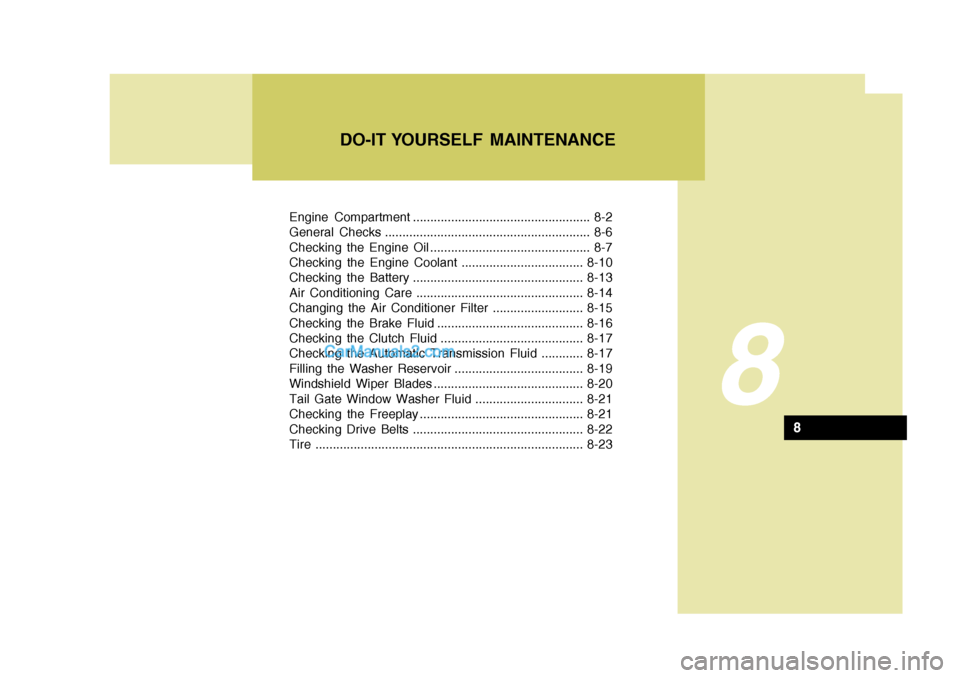
Engine Compartment ................................................... 8-2
General Checks ........................................................... 8-6
Checking the Engine Oil .............................................. 8-7
Checking the Engine Coolant ...................................8-10
Checking the Battery ................................................. 8-13
Air Conditioning Care ................................................ 8-14
Changing the Air Conditioner Filter .......................... 8-15
Checking the Brake Fluid .......................................... 8-16
Checking the Clutch Fluid ......................................... 8-17
Checking the Automatic Transmission Fluid ............ 8-17
Filling the Washer Reservoir ..................................... 8-19
Windshield Wiper Blades ........................................... 8-20
Tail Gate Window Washer Fluid ............................... 8-21
Checking the Freeplay ............................................... 8-21
Checking Drive Belts ................................................. 8-22
Tire ............................................................................. 8-23
8
DO-IT YOURSELF MAINTENANCE
8
Page 175 of 205
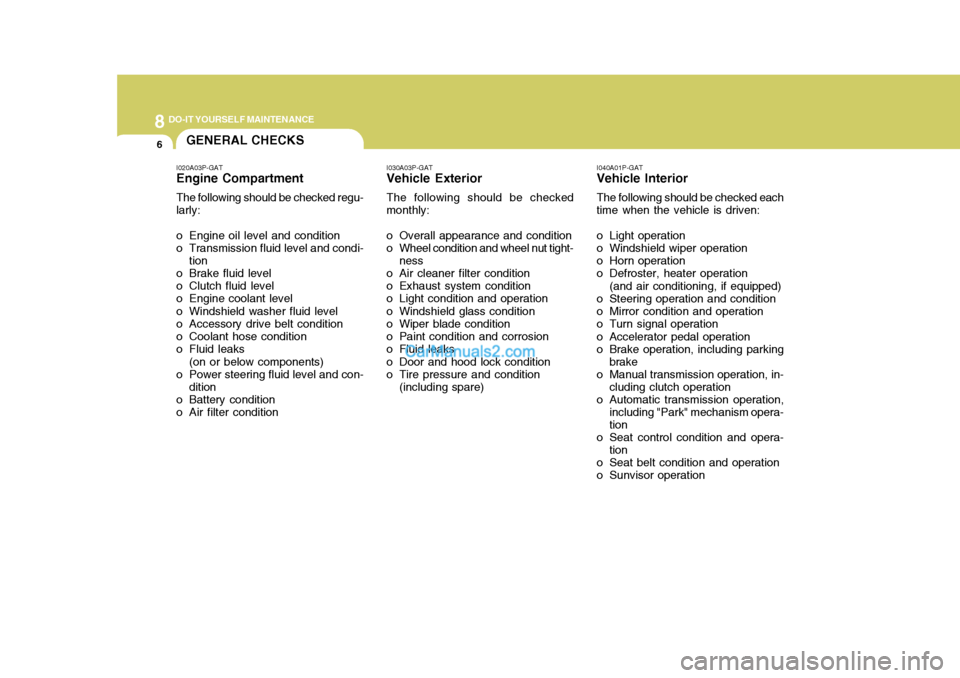
8DO-IT YOURSELF MAINTENANCE
6GENERAL CHECKS
I020A03P-GAT Engine Compartment The following should be checked regu- larly:
o Engine oil level and condition
o Transmission fluid level and condi- tion
o Brake fluid level
o Clutch fluid level
o Engine coolant level
o Windshield washer fluid level
o Accessory drive belt condition
o Coolant hose condition
o Fluid leaks
(on or below components)
o Power steering fluid level and con-
dition
o Battery condition
o Air filter condition I030A03P-GAT Vehicle Exterior The following should be checked monthly:
o Overall appearance and condition
o Wheel condition and wheel nut tight-
ness
o Air cleaner filter condition
o Exhaust system condition
o Light condition and operation
o Windshield glass condition
o Wiper blade condition
o Paint condition and corrosion
o Fluid leaks
o Door and hood lock condition
o Tire pressure and condition
(including spare) I040A01P-GAT Vehicle Interior The following should be checked each time when the vehicle is driven:
o Light operation
o Windshield wiper operation
o Horn operation
o Defroster, heater operation
(and air conditioning, if equipped)
o Steering operation and condition
o Mirror condition and operation
o Turn signal operation
o Accelerator pedal operation
o Brake operation, including parking brake
o Manual transmission operation, in-
cluding clutch operation
o Automatic transmission operation,
including "Park" mechanism opera-tion
o Seat control condition and opera-
tion
o Seat belt condition and operation
o Sunvisor operation
Page 183 of 205
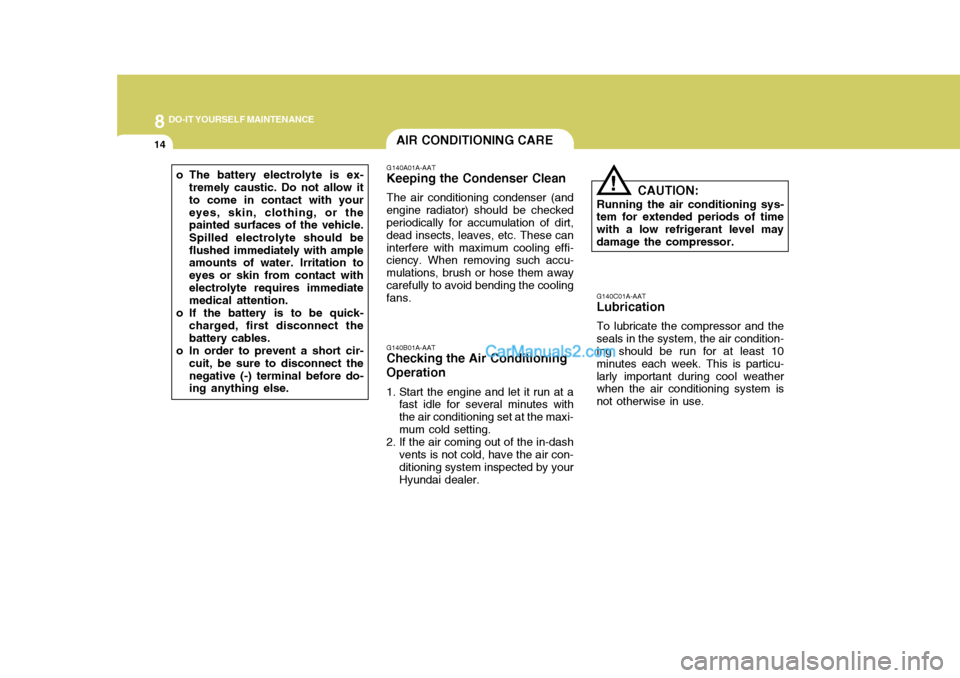
8DO-IT YOURSELF MAINTENANCE
14
o The battery electrolyte is ex-tremely caustic. Do not allow it to come in contact with youreyes, skin, clothing, or the painted surfaces of the vehicle. Spilled electrolyte should be flushed immediately with ample amounts of water. Irritation to eyes or skin from contact withelectrolyte requires immediate medical attention.
o If the battery is to be quick- charged, first disconnect the battery cables.
o In order to prevent a short cir- cuit, be sure to disconnect thenegative (-) terminal before do- ing anything else.AIR CONDITIONING CARE
G140A01A-AAT Keeping the Condenser Clean The air conditioning condenser (and engine radiator) should be checked periodically for accumulation of dirt, dead insects, leaves, etc. These caninterfere with maximum cooling effi- ciency. When removing such accu- mulations, brush or hose them awaycarefully to avoid bending the cooling fans.
G140B01A-AAT Checking the Air Conditioning Operation
1. Start the engine and let it run at a fast idle for several minutes with the air conditioning set at the maxi-mum cold setting.
2. If the air coming out of the in-dash
vents is not cold, have the air con-ditioning system inspected by your Hyundai dealer. G140C01A-AAT Lubrication To lubricate the compressor and the seals in the system, the air condition- ing should be run for at least 10 minutes each week. This is particu-larly important during cool weather when the air conditioning system is not otherwise in use.CAUTION:
Running the air conditioning sys- tem for extended periods of time with a low refrigerant level maydamage the compressor.
!
Page 184 of 205
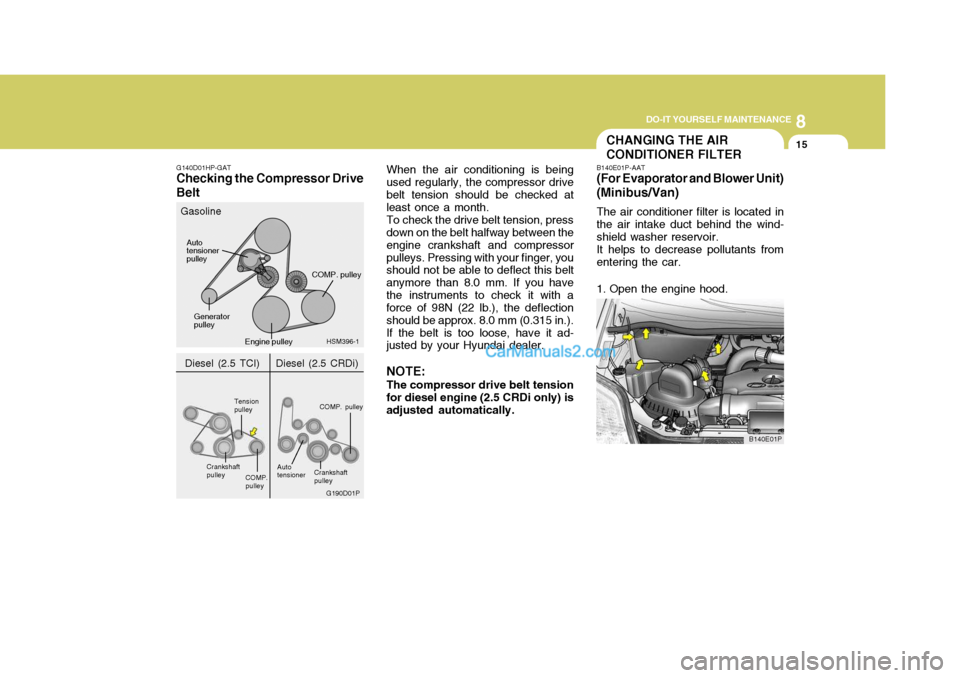
8
DO-IT YOURSELF MAINTENANCE
15
G140D01HP-GAT
Checking the Compressor Drive Belt When the air conditioning is being used regularly, the compressor drivebelt tension should be checked at least once a month. To check the drive belt tension, press down on the belt halfway between the engine crankshaft and compressorpulleys. Pressing with your finger, you should not be able to deflect this belt anymore than 8.0 mm. If you havethe instruments to check it with a force of 98N (22 lb.), the deflection should be approx. 8.0 mm (0.315 in.).If the belt is too loose, have it ad- justed by your Hyundai dealer. NOTE: The compressor drive belt tension for diesel engine (2.5 CRDi only) isadjusted automatically.
HSM396-1
Gasoline
CHANGING THE AIR CONDITIONER FILTER
B140E01P
B140E01P-AAT (For Evaporator and Blower Unit) (Minibus/Van) The air conditioner filter is located in the air intake duct behind the wind- shield washer reservoir. It helps to decrease pollutants from entering the car.
1. Open the engine hood.
Auto tensionerpulley
COMP. pulley
Engine pulley
Generator pulley
G190D01P
Diesel (2.5 TCI)
Crankshaft pulley
COMP.pulley
Tension pulley
COMP. pulley
Autotensioner Crankshaftpulley
Diesel (2.5 CRDi)
Page 201 of 205

10INDEX
2
A ADJUSTABLE FRONT SEATS ................................1-30
AIR CONDITIONER FILTER ........................... 2-47, 8-15
AIR CONDITIONING CARE .....................................8-14
AIR CONDITIONING SYSTEM ................................2-44
ALTIMETER .............................................................. 2-18
ANTENNA ................................................................. 2-73
ANTI-LOCK BRAKE SYSTEM ................................. 3-23
APPEARANCE CARE ................................................ 5-2
ASHTRAY ................................................................. 2-36
AUDIO FAULT CODE .............................................. 2-70
AUDIO SYSTEM Cassette Tape Player Operation (H240, H280)...................................................................... 2-54, 2-65
Compact Disc Player Operation (H260, H280)
...................................................................... 2-59, 2-67
Stereo Radio Operation (H240, H260, H280) ............................................................ 2-51, 2-56, 2-62
AUTOMATIC TRANSMISSION .................................. 3-9
AUTOMATIC TRANSMISSION FLUID ....................8-17
AUXILIARY SEAT ..................................................... 1-36BBACK WARNING
SYSTEM ..................................... 3-24
BATTERY ................................................................. 8-13
BEFORE STARTING THE ENGINE .......................... 3-2
BI-LEVEL HEATI NG ................................................. 2-42
BLEEDING THE FUEL SYSTEM ............................ 4-21
BRAKE FLUID .......................................................... 8-16
BRAKE PEDAL ......................................................... 3-21
BRAKE SYSTEM ...................................................... 3-19
BULB WATTAGE ...................................................... 4-38
CCARE OF CASSETTE TAPES ................................ 2-72
CARE OF DISC ........................................................ 2-71
CARRYING CHILDREN ............................................ 1-15
CATALYTIC CONVERTER .................. ...................... 7-3
CENTRAL DOOR LOCKS ......... ...............................1-14
CHANGING A FLAT TIRE ......................................... 4-7CHANGING AND REPLACING FUSES ..................4-27
CHECKING THE DRIVE BELTS .............................. 8-22
CHECKING THE FREEPLAY................................... 8-21
CHILD PROTECTION SLIDE DOOR .......................1-15
CHILD RESTRAINT SYSTEM ..................................1-43
CIGARETTE LIGHTER ............................................. 2-27
CLUTCH FLUID ........................................................ 8-17